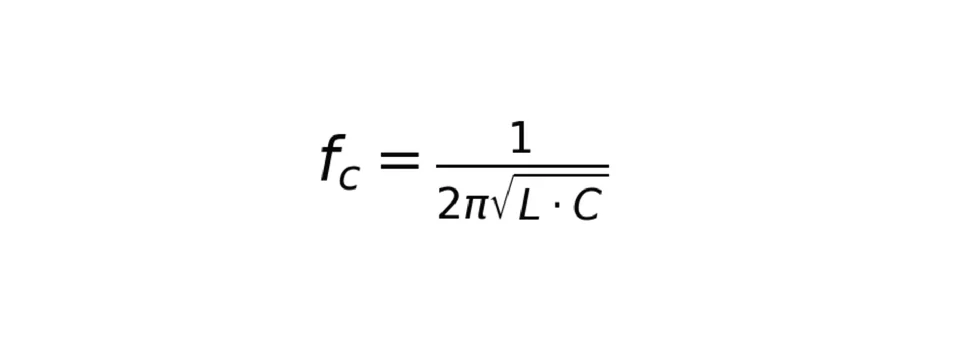Choosing the right RF filter is crucial to achieving optimal system performance, but it’s rarely...
Why Every Engineer Needs a Reliable Lowpass Filter Calculator

RF and electrical engineers have relied on lowpass filters to control frequencies and separate wanted signals from noise since the early days of Radio Frequency (RF) technology. In addition to the size and other factors, there’s an imperative mathematical foundation behind these tiny yet essential RF components that shape how signals are filtered.
The standard cut-off frequency formula for an ideal LC (inductor-capacitor) lowpass filter is:

LC Lowpass Filter Cut-off Frequency Formula
But the real world is not ideal, so taking into consideration load impedances and parasitics (like ESR), along with the careful selection of inductance (L) and capacitance (C) values allows for customizing the filter's response to balance roll-off sharpness with filter stability. It’s also vital to address environmental factors like vibration, extreme temperatures, and electromagnetic interference to achieve long-term efficiency. Relying only on textbook calculations risks overlooking these critical challenges.
How do you maximize the capabilities of your lowpass filter designs while accounting for trade-offs and external factors? This blog will explain how a reliable lowpass filter calculator, paired with expert guidance, can simplify your workflow and enhance your filter’s performance.
Why Do You Need a Lowpass Filter Calculator?
Industrial and defense applications demand lowpass filters that adhere to strict roll-off, insertion loss, and signal rejection specifications. High-frequency applications demand more rigid standards and often require custom-made LC lowpass filters. Material choices, component tolerances, and soldering techniques can also affect the stability of the cut-off frequency over time.
RF and electrical engineers understand that every component, down to the smallest inductor or capacitor, impacts the efficiency of a complex RF system. With the help of a lowpass filter calculator, you can streamline design processes, avoid unnecessary iterations, and achieve results that would otherwise take hours or days to fine-tune.
A lowpass filter calculator provides quick and accurate results for setting cut-off frequency according to your chosen inductance and capacitance values. This tool enables straightforward calculation and application of the necessary parameters for achieving optimal filter performance. Let’s examine the process in detail:
How Does the Lowpass Filter Calculator Work?
You can input cut-off frequency, impedance, and filter type into a lowpass filter calculator to determine the required inductor and capacitor according to specific design criteria. While some calculators use basic formulas, advanced versions incorporate synthesis techniques, such as those used in Butterworth, Chebyshev, and Elliptic filter responses, to customize the results according to application requirements. Lowpass filter calculators support various filter topologies and provide precise metrics to help optimize performance based on various trade-offs.
- Butterworth Lowpass Filter. Known for having a maximally flat frequency response in the passband, Butterworth filters minimize ripple and provide smooth signal handling.
- Chebyshev Lowpass Filter. Chebyshev filters offer a steeper roll-off but introduce controlled ripple in either the passband (Type I) or stopband (Type II), which is suitable for applications requiring rapid attenuation.
- Elliptic (Cauer) Lowpass Filter. Elliptic filters achieve the sharpest roll-off for a given order and minimize ripple in both passband and stopband, making them ideal for applications where high selectivity is critical.
- LC Lowpass Filter. The LC lowpass filter, which combines inductors and capacitors, is favored in military and aerospace applications due to its high power handling and reliability.
- RC Lowpass Filter. RC filters suit low-power and low-frequency applications well, offering straightforward designs under essential performance requirements.
Your chosen filter type and configuration must align closely with application-specific standards, which vary widely across defense, aerospace, and telecommunication fields. Roll-off characteristics and attenuation profiles often influence this decision. For example, a Butterworth filter may be selected for minimal ripple in signal quality, while Chebyshev or Elliptic filters provide sharper roll-offs suited to high-selectivity applications. Each topology, including LC configurations, offers distinct advantages and limitations, particularly regarding size, weight, and power capacity.
How Can You Use the Lowpass Filter Calculator?
- Define Requirements. Define parameters like cut-off frequency, ripple tolerance, load impedance, and roll-off rate to comply with system-level requirements, including MIL-STD-704 standards for military electrical power systems.
- Input Parameters: Enter the values into the calculator to make adjustments and perform trade-off analysis quickly.
- Analyze Results. Once the values are entered, the calculator will compute inductor and capacitor values that you can apply directly or fine-tune.
- Simulation and Adjustment. Many calculators offer simulation features to verify performance metrics critical for achieving MIL-STD-461 for EMI/EMC compliance in aerospace systems.
Factors That Can Affect Your Lowpass Filter Computation
Component Tolerances
No RF component is universally applicable in real-world applications. Capacitors and inductors come with manufacturing tolerances (such as ±5% and ±10%), meaning their actual values can vary from nominal specifications. Variations can alter the cut-off frequency and compromise filtering precision.
Understanding and accounting for these tolerances is essential for high-precision applications.
Environmental Factors
Military and aerospace environments often expose components to extreme temperatures, humidity, and vibrations, which can alter their properties. For instance, high temperatures may shift capacitor values, while inductors could face core saturation under heavy load, impacting filter accuracy and reliability.
Load Impedance
Load impedance refers to the inductance or capacitance encountered at the filter's output due to the connected load. Variations in load impedance can significantly impact the filter's frequency response, potentially alter cut-off characteristics, and degrade overall performance. A well-matched load, on the other hand, preserves filter behavior, stabilizes frequency response, and enables effective operation within designed parameters.
Parasitic Elements
Parasitic elements are unintended resistances, inductances, and capacitances inherent in circuit components or PCB layouts. Parasitics can cause frequency shifts and unanticipated resonances, especially in high-frequency circuits. RF and electrical engineers must minimize the impact of parasitic inductances and capacitances to maintain predictable filter performance.
Aging of Components
Electronic components degrade over time; capacitors can lose capacitance, and inductors may drift from their original values. Such changes can alter the intended filter response, impacting the performance of systems that demand long-term reliability.
Frequency Range of Operation
The frequency range over which the filter is intended to operate also significantly influences its design and performance. Components that behave well at lower frequencies may exhibit non-ideal behaviors at higher frequencies.
Accurate lowpass filter design requires carefully selecting components that perform consistently across the target frequency range, especially in RF applications in aerospace systems that reach very high frequencies.
Design Efficient Lowpass Filters with the Help of Seasoned RF Experts
A lowpass filter calculator is invaluable for achieving precise filter specifications, but collaborating with an experienced RF partner, such as Q Microwave, can further optimize designs for real-world conditions. Seasoned RF engineers offer advanced design kits, custom components, and validation of calculator outputs. They will also bring best practices, advanced tools, and expertise to achieve your project requirements and industry standards.
Q Microwave provides a comprehensive approach to RF solutions, beginning with a deep understanding of your project. We work closely with you to understand your requirements and offer design solutions following your performance goals under AS 9100 and ISO 9001 standards. Q Microwave experts will meticulously assemble, test, and fine-tune each filter to deliver optimal frequency response, insertion loss, and attenuation.
Partner with Q Microwave to achieve precision engineering and custom RF solutions. Benefit from quality testing and a team committed to your objectives and industry standards.
Begin Your Path to Precision-Engineered Lowpass Filters for High-Frequency RF Applications
Accurate lowpass filter calculations are critical for RF engineers working on aerospace and defense projects. Even a tiny error can result in difficult-to-resolve performance issues. Partnering with a trusted expert like Q Microwave guarantees that every lowpass filter is carefully customized to your specifications, thoroughly tested for demanding conditions, and designed to perform reliably in critical applications.
Contact Q Microwave today to discuss your project requirements and discover how our custom lowpass filters and expert support can help you achieve reliable lowpass filter performance.



